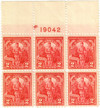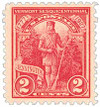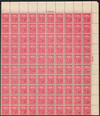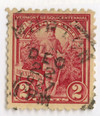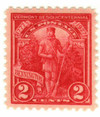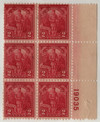
1927 2c Vermont Sesquicentennial
# 643 - 1927 2c Vermont Sesquicentennial
$1.20 - $300.00
U.S. #643
1927 2¢ Vermont Sesquicentennial
1927 2¢ Vermont Sesquicentennial
Issue Date: August 3, 1927
First City: Bennington, VT and Washington, DC
Issue Quantity: 39,974,900
Vermont served mainly as a hunting ground for the tribes of the Algonquian Indians before white settlement. Frances Samuel de Champlain was the first European to explore the Vermont area. He reached Lake Champlain, which bears his name, in 1609. Champlain claimed all of Vermont for France. In 1666, the French built a fort on Isle La Motte in Lake Champlain. The English built a fort at Chimney Point, west of todays Middlebury, in 1690. However, the first permanent settlement was Fort Dummer, near todays Brattleboro, built by colonists from Massachusetts in 1724. This fort was needed to protect western Massachusetts from attacks by the French and Indians. Vermont was a battleground during the French and Indian War (1754-1763). The war resulted in Englands control of Vermont and most of North America.
U.S. #643
1927 2¢ Vermont Sesquicentennial
1927 2¢ Vermont Sesquicentennial
Issue Date: August 3, 1927
First City: Bennington, VT and Washington, DC
Issue Quantity: 39,974,900
Vermont served mainly as a hunting ground for the tribes of the Algonquian Indians before white settlement. Frances Samuel de Champlain was the first European to explore the Vermont area. He reached Lake Champlain, which bears his name, in 1609. Champlain claimed all of Vermont for France. In 1666, the French built a fort on Isle La Motte in Lake Champlain. The English built a fort at Chimney Point, west of todays Middlebury, in 1690. However, the first permanent settlement was Fort Dummer, near todays Brattleboro, built by colonists from Massachusetts in 1724. This fort was needed to protect western Massachusetts from attacks by the French and Indians. Vermont was a battleground during the French and Indian War (1754-1763). The war resulted in Englands control of Vermont and most of North America.



